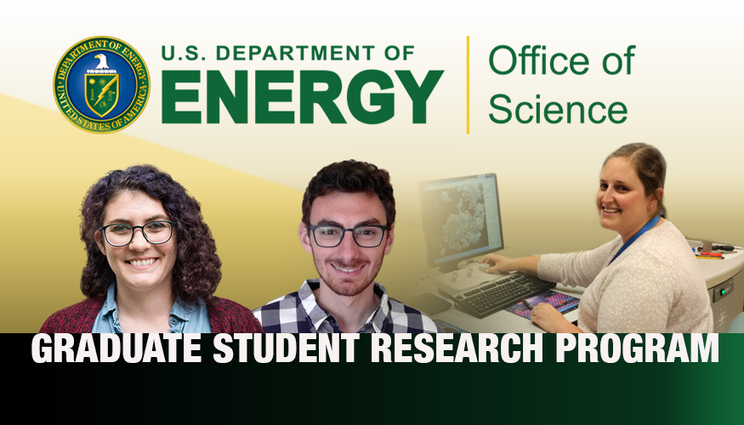Graduate students earn awards to work at LLNL
 (Download Image)
Three graduate students have earned Department of Energy Office of Science Graduate Student Research Program awards to perform their doctoral dissertation research at Lawrence Livermore National Laboratory. From left: Alison Dreyfuss, Andrew Gasbarro and Katie Hoffman.
(Download Image)
Three graduate students have earned Department of Energy Office of Science Graduate Student Research Program awards to perform their doctoral dissertation research at Lawrence Livermore National Laboratory. From left: Alison Dreyfuss, Andrew Gasbarro and Katie Hoffman.
Three graduate students have earned Department of Energy Office of Science Graduate Student Research (SCGSR) Program awards to perform their doctoral dissertation research at Lawrence Livermore National Laboratory (LLNL). The prestigious award helps cover living expenses and travel for 53 students from universities across the nation. Their proposed research projects address scientific challenges central to Office of Science mission areas from nuclear physics to environmental systems.
Alison Dreyfuss: Louisiana State University
Dreyfuss will be looking at reaction mechanisms for nuclei as well as some nuclear observables by combining successful structure models with reaction models. Developing a reaction model that uses information from structure models will give the researchers a better idea of what’s happening in high-energy states. Introducing a symmetry approach allows the team to describe the models with less computational effort. Dreyfuss sees the award as an opportunity to see the atmosphere of a national lab and how projects are organized.
"Government-funded research programs like this expose young scientists at all levels to a professional experience in science and is important for diversifying science as well," Dreyfuss said. "I’m able to expand on my research with resources that I simply don’t have access to at school, and that is really powerful. Lawrence Livermore has such a strong nuclear theory team."
Andrew Gasbarro: Yale University
Gasbarro will study strongly interacting quantum field theories using Lattice Gauge Theory, Monte Carlo techniques and massively parallel supercomputers. In these systems, strong forces bind small particles together into larger composites in the same way that quarks are bound together to form protons and neutrons in nuclear physics. Gasbarro hopes his work in particle physics leads to possible solutions to outstanding problems in the Standard Model.
"The knowledge I will gain about cutting-edge computing resources and lattice gauge theory techniques will allow me to carry out calculations and achieve physics results to include in my dissertation, which would not otherwise be possible," Gasbarro said. "LLNL is exceptional in this combination of intellectual strength and pioneering supercomputing facilities."
Katie Hoffman: University of Cincinnati
Hoffman will be investigating the behavior of radioactive isotope cesium-137 in the environment by analyzing soils from several contaminated locations such as the Marshall Islands and Fukushima. The results will improve scientific understanding of the interaction of cesium-137 and the subsurface as well as inform better predictions of its migration.
"I hope to expand my knowledge of radioanalytical techniques and learn more about method development in a national laboratory setting," Hoffman said. "I've had two great experiences at LLNL previously, when I participated in internships at LLNL during the summers of 2015 and 2016. The working relationships I developed during those internships along with the state-of-the-art instrumentation available made choosing LLNL for this project easy."
The SCGSR program is sponsored and managed by the DOE Office of Science’s Office of Workforce Development for Teachers and Scientists, Office of Science research programs and DOE national laboratories.
Contact
Kate Hunts[email protected]
925-422-1322
Related Links
Department of Energy Office of Science Graduate Student Research (SCGSR) ProgramDOE Office of Science’s Office of Workforce Development for Teachers and Scientists
Tags
HPC, Simulation, and Data ScienceComputing
Physical and Life Sciences
Careers
Featured Articles







